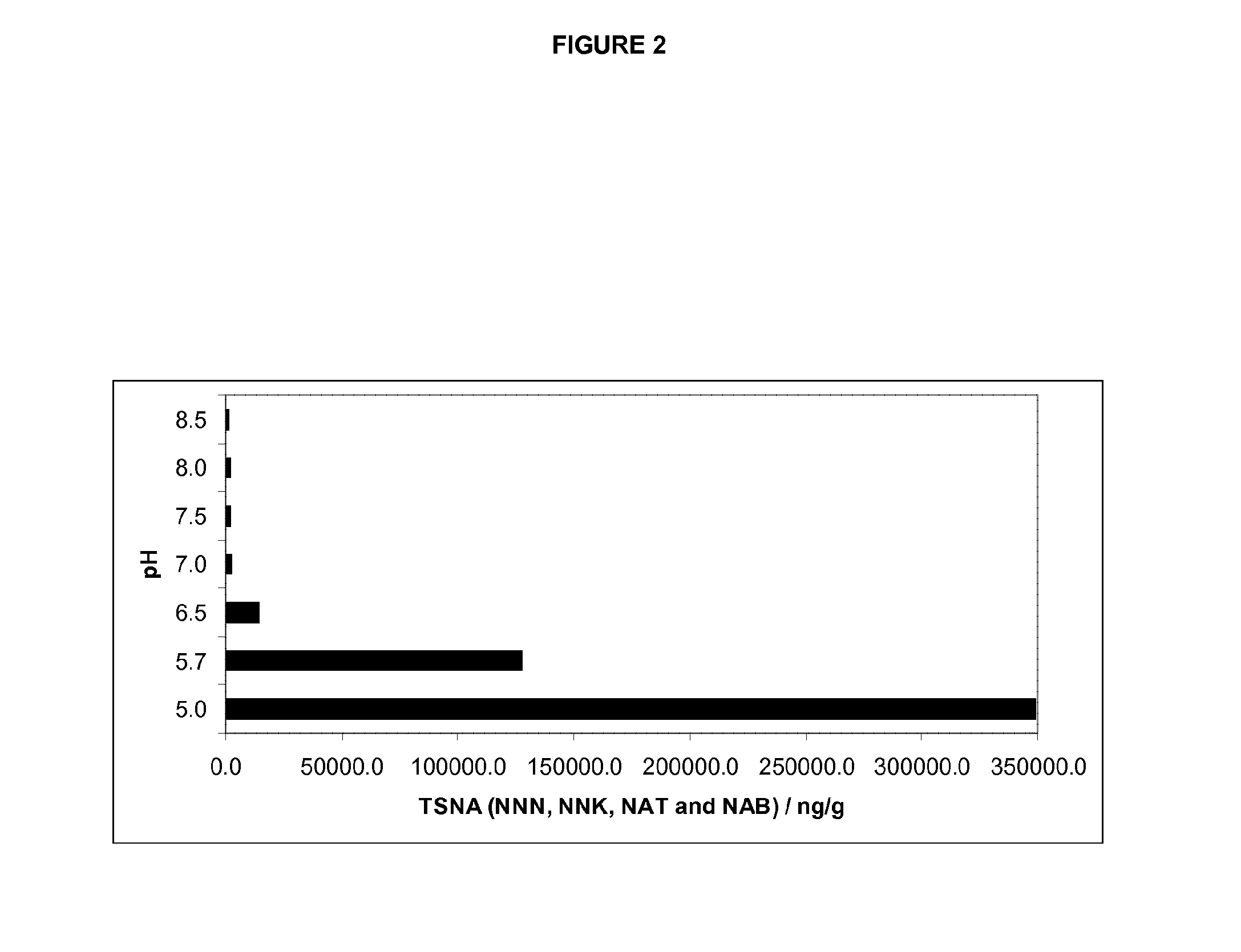Methods for reducing the formation of tobacco specific nitrosamines in tobacco homogenates
a technology of specific nitrosamine and tobacco homogenate, which is applied in the field of methods, can solve the problems that tobacco stems and tobacco fines from manufacturing processes are unsuitable for use directly in the manufacturing of tobacco products, and achieve the effects of reducing the effect of increased ph, reducing or inhibiting the generation of de novo tobacco specific nitrosamine in tobacco homogenates, and reducing the elevated level of de novo generated
- Summary
- Abstract
- Description
- Claims
- Application Information
AI Technical Summary
Benefits of technology
Problems solved by technology
Method used
Image
Examples
example 1
Materials & Methods
[0090]Tobacco slurry is prepared by mixing finely ground Burley tobacco with sterile distilled water to obtain a 10% (w / v) mixture. The mixture is incubated for 2 hrs at room temperature while stirring with a magnetic stirring rod. The pH of the mixture is measured and then the mixture is divided into two equal parts. The pH of one of the parts is adjusted to pH 7.0 using 10N KOH. 10-ml aliquots of the unadjusted pH and the pH 7.0 mixtures are transferred into 50-ml falcon tubes and pseudooxynicotine and KNO2 solutions are added to the samples to obtain the desired final composition. The samples are prepared in complete factorial design in which the factors pH, pseudooxynicotine and nitrite are used at (unadjusted 5.7, 7.0); (0, 100, 250 μg / ml); and (0, 1, 10, 50 mM) levels, respectively. Nitrosation is allowed to occur at room temperature for about 16 hrs. The alkaloid and tobacco specific nitrosamine content of the samples is analyzed by standard methods using g...
example 2
Tobacco Specific Nitrosamine Spikes in a Tobacco Slurry are Accompanied by Elevated Nitrite Levels
[0091]To determine the impact of increasing the pH of tobacco homogenate on tobacco specific nitrosamine formation, the pH of a tobacco slurry is adjusted to pH 7.0 and the tobacco specific nitrosamine content of the mixture is analysed in the presence of various levels of tobacco specific nitrosamine precursors, such as pseudooxynicotine and nitrite. The results indicate that, regardless of pH, the addition of pseudooxynicotine to the mixture significantly increases 4-(methylnitrosamino)-1-(3-pyridyl)-1-butanone levels only when ≧1 mM nitrite is also supplied to the slurry. These results suggest that in the presence of sufficiently high nitrite concentrations (for example, at least about 1 mM), pseudooxynicotine is readily converted into 4-(methylnitrosamino)-1-(3-pyridyl)-1-butanone, and in the slurry nitrite levels limit 4-(methylnitrosamino)-1-(3-pyridyl)-1-butanone formation. Altho...
example 3
Increasing the pH of a Tobacco Slurry Reduces the Levels of All Four Species of Tobacco Specific Nitrosamines
[0092]Adjusting the pH of the slurry from its naturally-occurring value of pH 5.7 to pH 7.0 sharply decreases the levels of all four species of tobacco specific nitrosamines when >1 mM nitrite is added to the mixture. The rate of tobacco specific nitrosamine reduction is dependent on the concentrations of pseudooxynicotine and nitrite in the slurry. The greatest % of total tobacco specific nitrosamine reduction (approx. 98%) is achieved at 50 mM nitrite levels followed by 90% at 10 mM nitrite and 12% at 1 mM nitrite concentration. The reduction of individual tobacco specific nitrosamines follows the same trend as total tobacco specific nitrosamines with the exception of 4-(methylnitrosamino)-1-(3-pyridyl)-1-butanone (FIG. 1). Firstly, % reduction of 4-(methylnitrosamino)-1-(3-pyridyl)-1-butanone is smaller than the other tobacco specific nitrosamine species reaching its maxim...
PUM
 Login to View More
Login to View More Abstract
Description
Claims
Application Information
 Login to View More
Login to View More - R&D
- Intellectual Property
- Life Sciences
- Materials
- Tech Scout
- Unparalleled Data Quality
- Higher Quality Content
- 60% Fewer Hallucinations
Browse by: Latest US Patents, China's latest patents, Technical Efficacy Thesaurus, Application Domain, Technology Topic, Popular Technical Reports.
© 2025 PatSnap. All rights reserved.Legal|Privacy policy|Modern Slavery Act Transparency Statement|Sitemap|About US| Contact US: help@patsnap.com


